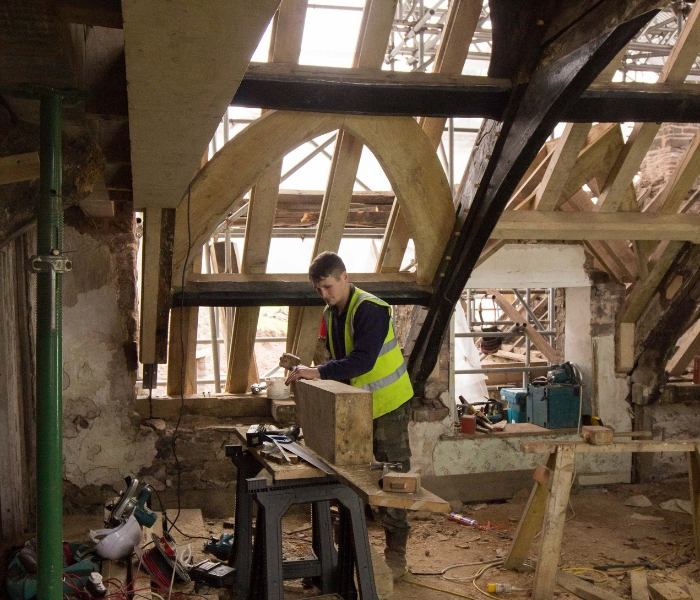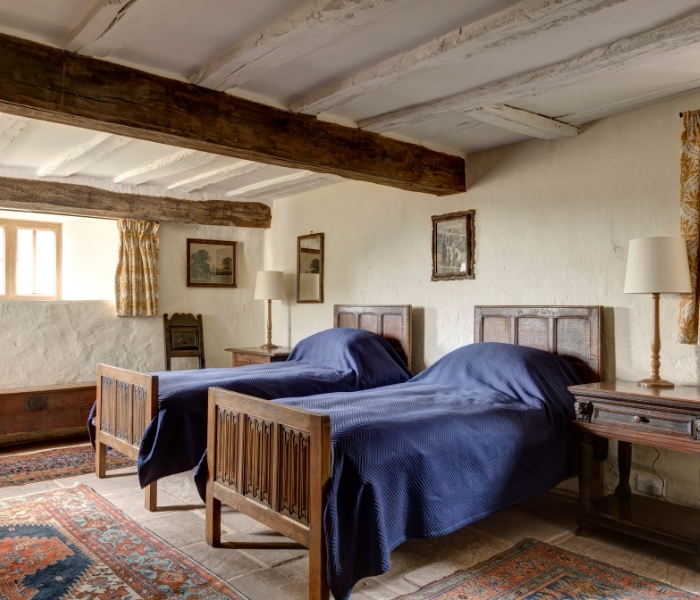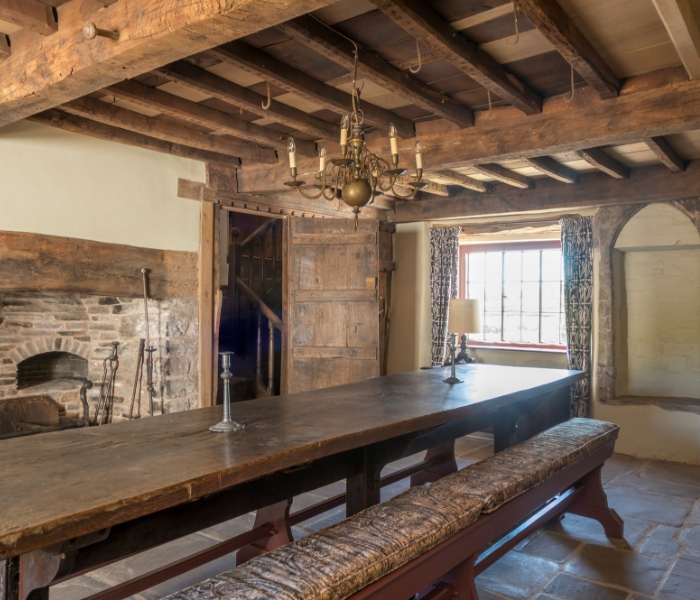Even after almost six decades, Landmark still gets well over a hundred approaches each year for buildings we might help with. Most don’t meet our simple baseline criteria (Does it need us? Is it important? Would it be nice for a holiday?) but just occasionally one lands and you think ‘we have to save this.’

That’s what happened a decade ago, when a letter arrived from an architect at Cadw, seeking Landmark’s help with a Grade I late-medieval house called Llwyn Celyn, in the Llanthony Valley in Monmouthshire. The house was hanging on by a thread, and invisible beneath a cocoon of emergency scaffolding and sheeting. But he included a few outdated black and white photos, showing sinuously carved doorheads astonishing for the setting, and his letter mentioned a spere truss, a high-end fixed bench, a two-storey solar cross range. At such moments, the pulse quickens.
And it’s a strange thing that those first visits to a possible project, when the building is at its lowest ebb, are often the most exciting. Mostly boarded up, Llwyn Celyn was dank and crammed with the detritus of former lives. Some of its floors were bare earth – nay, mud, as water trickled through from the hillside behind. And yet. A mighty medieval door creaked open to let us in. The medieval floor plan was still intact, the flagstones trodden by centuries of feet. A bat roosted in a corner. Two beautifully carved doorheads stood crooked but intact. One had shields – whose arms did they once bear?
We probably don’t say much to each other during those first visits, as the sense of antiquity enfolds you. Afterwards, round the office table, we’ll examine the technical and funding feasibilities more analytically, but for all of us, that first rush of empathy and then determination is what underpins all that follows – ‘only we, Landmark, can save this.’

Ten years on, Llwyn Celyn has tested every sinew of our long experience of such transformations. First, the scale of the task: not just the high status, Grade I house of exceptional significance, but also a later threshing barn and other important outbuildings, in an equally parlous state. £4.2 million raised, we were then on site for two years, battling bats and snowstorm as skilled professionals and craftsmen gently nursed Llwyn Celyn’s failing fabric back to new life. Traditional craft skills were promoted and shared. Volunteers too made a useful contribution to the outbuildings and landscape while learning new skills. Late in the process came the revelation that Llwyn Celyn had been built in 1420, intriguingly soon after Owain Glyn Dŵr and Henry IV’s armies ravaged the area in 1404-5. It is indeed an exceptional survival.
The threshing barn has become a community centre, and the beast house an interpretation room about the site and the wider valley. Thanks to the HLF funding, we delivered a humming programme of outreach throughout the project, making many new friends and learning much from them.
Llwyn Celyn is just the latest example of the difference Landmark makes. For more than fifty years, villages, towns and cities throughout Britain are richer for the buildings Landmark has rescued that survive to grace village high streets, enthuse local school children about their past, and inspire local history societies. We work hard to make sure that such local communities feel connected with the Landmarks that stand in their midst, with free public open days each year, often timed to coincide with a local fete or festival.

And Landmark’s powers of transformation go beyond physical fabric. Staying in our buildings can transform a state of mind, providing inspiration, respite, invigoration. In recent years, we have introduced two programmes to extend these psychologically transforming benefits as widely as possible. Our Fifty for Free scheme offers fifty free stays to the beneficiaries of other charities, vulnerable people bruised by life who may not be able to afford a holiday at all. Universities and research teams can also apply for one of ten free study breaks annually, through the Landmark Futures scheme.
What we do is not about turning back the clock. We believe above all in the power of fine historic buildings to make a difference in people’s lives, both now and in the future. These are precious and finite resources; we hope you will share our passion to protect them, and join us in our commitment to conserve them by staying in our buildings and supporting our work.